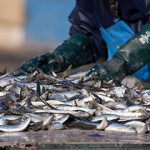SuperGround pioneering tech that turns fish bones into food

A year after launching technology that enables food manufacturers to utilize ground-up chicken bones and hard tissues in their products, Finnish food tech company SuperGround has expanded into the seafood space.
SuperGround's patented process softens, heat-treats, and grinds fish byproducts – including previously unusable bones, skin, scales, and other hard tissue – into a thick paste that can be used in the production of fish sticks, fish nuggets, fish soups, and more.
“For the first time, everything except the guts can be used in the production of consumer-friendly fish products,” SuperGround Founder and Chief Innovator Santtu Vekkeli told SeafoodSource.
Vekkeli said he was looking for new ways to implement his technology when he realized that fish bones are similar to chicken bones.
“They are both small and soft, which means that with simple modifications, both can be processed with the same equipment,” he said.
The process releases collagen from the calcium phosphate structures in the hard tissues, along with vitamins and minerals. As a result, incorporating the paste into manufactured products increases the nutritional value, as the products include a higher volume of protein, vitamins, calcium, and omega-3 fatty acids compared to simple fish fillets.
The basic machinery can produce 500 to 650 kilograms of paste per hour, and up to 1.5 million kilograms per year, but multiple machines can be placed on an integrated processing line. According to Vekkeli, the transformation process is very quick, taking around three minutes to complete.
Vekkeli said he was inspired to perfect the seven-stage transformational process as a small step towards fighting the global issues of overfishing and food waste, which in turn helps to address food security.
“We estimate that the process allows between 20 to 60 percent more food to be produced from fish than was previously possible, depending on the species. This is important, as global demand for seafood is expected to grow over the next decade, particularly in high-income and upper middle-income countries,” Vekkeli said.
According to global data from Statista, the fish and seafood industry achieved an estimated annual revenue of USD 612 billion (EUR 571 billion) in 2023, which will grow by 6.23 percent per year to 2027. Volume growth will be around five percent in 2024, and reach more than 39,000 million kilograms by 2027.
“People are developing plant-based alternatives to help save the planet, but not everyone wants to eat these. Many people want to keep eating real seafood, but with a clear conscience,” he said. “Our solution for producing more tasty fish products without putting additional pressure on the fishing industry is a win-win situation.”
Vekkeli said trials have shown …
Photo courtesy of SuperGround




Share